Abstract
The relevance of the analysis of Sustainable Development Goals is based on the 2030 Agenda for Sustainable Development. The purpose of the study is to create a model of management/regulation of the quality of education and scientific research systems based on Sustainable Development Goals. The data of the ratings that reflect certain tasks of the Sustainable Development Goals, including those related to educational and scientific activities, are analyzed. The methodology of calculating the index of the success of realization of separate purposes of sustainable development is used. Bibliometric analysis as a research tool is used to create a quality of education management model. The example of the roadmap for achieving SDGs within the relationship chain “quality of education and science + partnership and networks–innovation–socio-economic impact–sustainable development goals” is provided. The suggested methodology for determining the index of success in achieving Sustainable Development Goals includes managing education systems, implementing scientific research, and managing/regulating the economy on micro-(university), meso-(regional), and macro-(national) levels. The tool in this case is a strategy for achieving KPIs, which can be fundamentally implemented in the form of a roadmap, with detailing of its elements using other tools. The “management/regulation” stage of the process of achieving Sustainable Development Goals is concretized by a mind map.
1. Introduction
For more than 40 years, sustainable development (since the introduction of the term “sustainable development” as a world priority in 1980 in the World Conservation Strategy [1]) has been a global goal of humankind and is subjected to detailed studies by the wide research community. The gradual transformation from linking sustainable development only with natural resources to reflecting social, economic, legal, and other aspects has led to the fact that sustainable development is viewed as a complex, interdisciplinary, and intersectoral problem. Note that the relationship between sustainable development, the quality of educational and scientific activities, and socio-economic development emerged only 20 years later with the adoption of the Millennium Development Goals (MDGs) in the United Nations Millennium Declaration [2].
While the MDGs in the context of education were mainly focused on basic education and its accessibility, Sustainable Development Goals (SDGs), formulated within Transforming our world: the 2030 Agenda for Sustainable Development [2], allow to effectively underline interconnections between social, economic, ecological problems, and education. The wider scope of countries engaged in SDG achievements offers the opportunity to study multicultural cases on the matter.
With the introduction of SDGs 4, 8, and 17, a strong relationship has emerged between the education quality and the creation of a network aimed at generating innovative industrial solutions due to ensuring the scientific research quality. The consequence of this is the sequential solution of tasks within the framework of other SDGs (for example, SDGs 6, 12, 13, 14, 15) and an approach to the fulfilment of the defining SDG 9 (Figure 1).
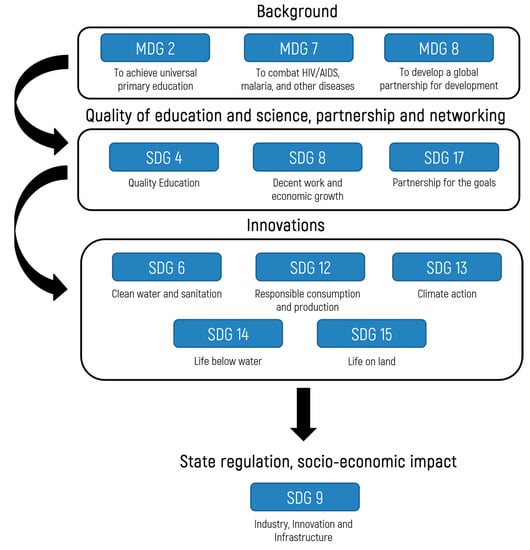
Figure 1.
Causal relationship between MDGs and SDGs. Source: authors’ development.
The transformation of development goals from MDGs to SDGs did not affect the main outcome of providing quality education and creating a large-scale basis for successful socio-economic development of regions. As can be seen from Figure 1, the path from ensuring the quality of education to innovation is paved through reliable partnerships and favorable starting conditions for the “technological push” in the promotion of the relevant SDGs.
2. Literature Review
The relevance of the study of the “quality of education–quality of scientific research–socio-economic growth–sustainable development” chain after the emergence of SDGs led to the publication of a wide range of works in this area.
Publication array analysis made it possible to outline several problems that are considered by the authors as applied to the specified chain, its individual elements, and the relationship between them:
- Innovative development of industry and economic prerequisites for it [3,4,5,6];
- Quality of education, institutional development, and the creation of research universities [7,8,9,10,11,12,13,14];
- Formation of an entrepreneurial university model as a consequence of ensuring the educational and research activity qualities [15,16,17,18,19];
- Description of specific SDGs in the proposed chain and ways to support them [20,21,22];
- Impact of clean energy on SDGs [23,24,25,26,27];
- Progress of environmental education in different countries and communities [27,28,29,30].
As noted in [31,32], one-third of the world’s countries have established appropriate learning assessment mechanisms to track trends over time, and one in four countries are conducting a learning outcome analysis in order to reform curricula. The smallest interaction between national plans and country education commitments is manifested in the absence of intersectoral cooperation, which usually develops only between preschool and health care institutions and then between educational institutions and labor market institutions. The aim of this study is to create a management/regulation model of the quality of education and scientific research systems based on SDGs.
3. Methods
The relationship between the quality of education and research within the entrepreneurial universities as the ultimate tool for implementing sustainable development policies can be traced based on the results of bibliometric analysis (Figure 2 and Figure 3). During the research period 2016–2020, the number of analyzed articles is ~5000. As can be seen from Figure 2 and Figure 3, the transformation of the quality of education and research into applied aspects (performing tasks within the SDGs, implementing the technology transfer process and the entrepreneurial university model, institutional development) is obvious and keeps the relevance up. At the same time, the issue of transforming the quality of education into the quality of knowledge and technology transfer and the creation of an entrepreneurial university is studied mainly in the fields of knowledge “Economics, Econometrics, and Finance”, “Business, Management, and Accounting”, “Social Sciences”, and “Decision Sciences”. This indicates an interest not actually in obtaining applied results based on knowledge, but mostly in the phenomenon of the formation of a high-quality educational environment, which is transformed into effective models of socio-economic development.
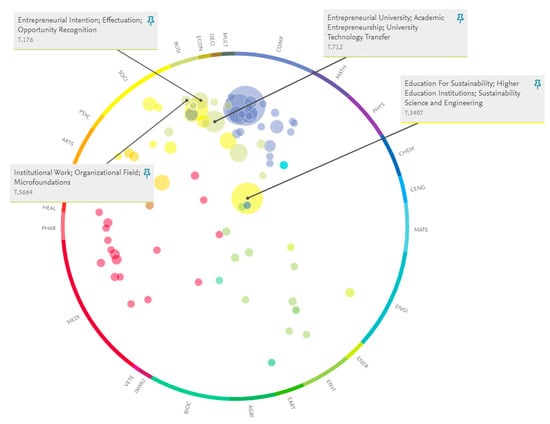
Figure 2.
Top 1% topics by prominence by query “quality of education and science”. Source: compiled by authors using SciVal tool.
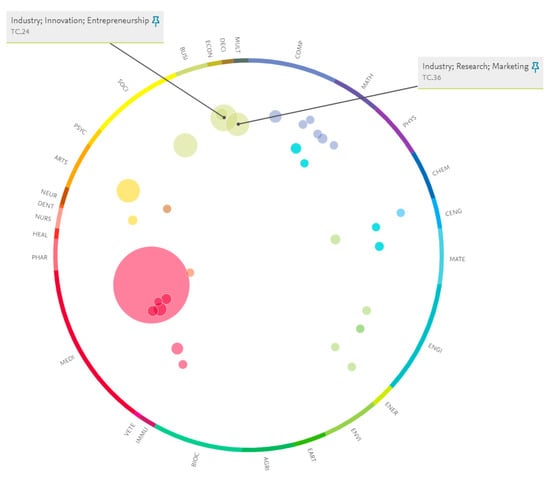
Figure 3.
Top 5% topics by prominence by query “quality of education and science”. Source: compiled by authors using SciVal tool.
This fact determines the main goal of the presented work: the creation of a model of management/regulation of the quality of education and scientific research systems aimed to solve urgent problems in the framework of SDG implementation along with the construction of quality assurance systems for educational and scientific activities at the local, regional, and national levels. It is also of interest to analyze the degree of SDG implementation in different countries, with the proposal of a tool for assessing the success in achieving indicators and ranking countries by individual indicators.
4. Results
This section represents an attempt to provide comprehensive tools for assessing SDG achievement success along with linking it to the components of the chain “quality of education and science + partnership and networks–innovation–socio-economic impact–sustainable development goals”. While the milestones and their importance in this chain are obvious, the connections between them have to operate on some quantitative background, e.g., ratings and statistics.
As the data show (Table 1), SDGs 4, 8, and 9 bear decisive importance for the EU countries in building a state development model based on the implementation of targets within Agenda 2030. Due to the differences in assessing the influence degree of various SDGs, the relevance rate of SDGs in the world may differ from that shown in Table 1 for other regions. Thus, considering the possible priorities in SDG achieving strategy in a particular territory, it may be analyzing not only the SDG Index rating, but also individual ratings, which are related to the targets and KPIs of various SDGs at a certain degree (Table 2).

Table 1.
Relative importance of each SDG in 27 EU countries and former EU member, the United Kingdom.

Table 2.
Country places distribution in various ratings.
This paper appropriates the following ranges for “zones” assigned by place occupied in a rating:
- “Green” zone: place 1–20 in the rating;
- “Yellow” zone: place 21–40 in the rating;
- “Orange” zone: place 41–60 in the rating;
- “Red” zone: place 61+ in the rating.
One should note that the “zoning” introduced here is not aimed at the global distribution of countries and is designed to be applicable in the context of the Table 2 selection of ratings. However, the general approach may be of interest for further research and the idea of developing a relevance index for a certain rating may answer the questions of rating selection subjectivity.
Figure 4 data show that one country can simultaneously belong to different zones of success in achieving the targets of Sustainable Development Goals. In this case, the ranking place has a significant impact on the overall success rate. Figure 4 visually demonstrates a fairly wide range of ranking places for one country. However, the lack of leadership in local ratings (corresponding to a particular SDG target) does not mean that the country is unsuccessful in its progress. The place in the designated rating may not reflect real progress in achieving a rating indicator. The evaluation of success in achieving Sustainable Development Goals based only on the analysis of the ranking place can be biased due to the fact that the absolute values of the indicator in the rating may differ disproportionately. A situation may arise when the previous and subsequent places in the rating differ minimally. The opposite situation can state a significant difference in indicators for neighboring places in the ranking.
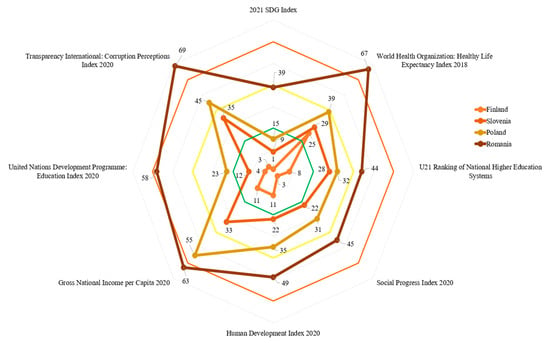
Figure 4.
Green, yellow, orange, and red zones of country places distribution in various ratings. Source: developed by authors based on data presented in Table 2.
In the case described above, one should refer not to the place assigned in a rating, but to the indicator (numerical value) characterizing the lag behind the leader or a group of leaders, e.g., the rating of world countries according to the education level index [34] shows that the difference between the indicator values of 1st and 10th places is 0.025 (0.943 versus 0.918 with the maximum theoretical value of the indicator equal to one). Another example is the rating of national higher education systems [35], where the 1st place determines the attainable maximum (100%) and the 10th place has an indicator 19.4% lower than the leader.
In this case, the normalization of rating values can act as an objective approach to assessing a complex indicator of success in ratings. The complex indicator of success can be calculated using the following algorithm:
- Rating selection.
- Normalization of the rating indicator value (to 1 or to 100%).
- Introduction of the weighting coefficient for selected rating.
- Calculation of a complex indicator of success using the formula:
- ●
- Option 1 (considering the influence of each rating on the final result as equal): the arithmetic means of the numerical rating indicators reduced to one;
- ●
- Option 2 (considering the influence of each rating on the final result as unequal): the sum of the products of the given rating indicator and the weight of the particular rating with the total sum of weight coefficients equal to one.
The second option is more flexible and can take into account the priorities in the implementation of certain SDG targets in a specific period. Another advantage of the second option is the ability to assess the degree of fulfilment of each target (defined by a specific rating) and to determine bottlenecks in ensuring the success rate.
Despite the prestige of the leading positions, it is the positive dynamics and progress that demonstrate reform success at all levels in the country. Achieving a significant increase in the numerical value of the rating indicator becomes possible with a consistent action plan “operation–tactics–strategy”. The roadmap shown in Figure 5 allows accounting for the peculiarities of the action plan implementation at micro- (university), meso- (regional), and macro- (national) levels. Each of the levels has its own set of tools for step-by-step achievements of operational, tactical, and strategic goals, as well as means of “scaling” tools to a higher level. Approaches to the implementation of the process of knowledge transfer through the means of (P, C, S, V) are formed based on the criteria of similarities of certain processes at different levels.
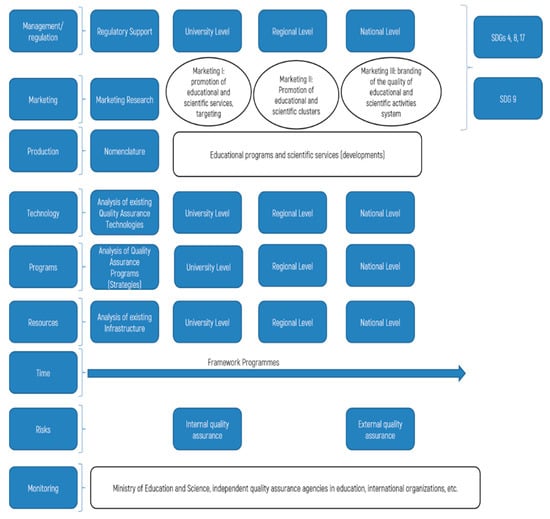
Figure 5.
SDGs achieving roadmap. Source: developed by authors.
The roadmap identifies the individual levels of preparation and implementation of the action plan, arranged hierarchically. An important property of the roadmap is the presence of “horizontal” links, which fulfil the need to move from operation (university level) to tactics (regional level) and then strategy (national level) within each hierarchical level. For a detailed description of these connections, a mind map can be used, an example of which form the “management/regulation” stage, as shown in Figure 6.
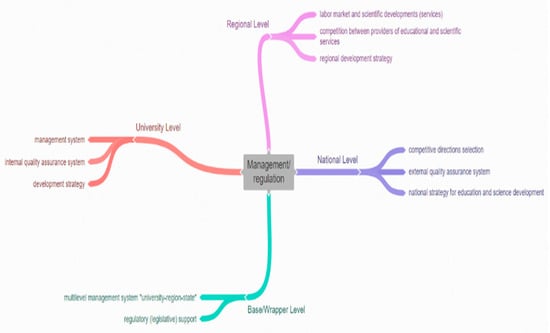
Figure 6.
Mind map for the management/regulation stage of the roadmap. Source: developed by authors.
The mind map presented in Figure 6 containing the Base/Wrapper level does not present in the general roadmap (Figure 5). This level is actually present on all roadmap stages but can vary due to the different natures of milestones. The mind map deciphers the essence of each of the levels on which the “education–science–business” relationship is built and indicates the criteria for evaluating the effectiveness of the functioning of each of the levels. The expansion of the mind map to the detailing of each tool at a separate level and the filling of each sub-level takes place within the limits of the autonomy granted to universities, regional strategic development plans, the state of development of certain industries, etc.
5. Discussion
Despite the fact that today there are many works dedicated to environmental education and achieving the SDGs [6,11,13,14,19,20,28,29,30], our analysis of the evolution of the main targets and their expansion within the framework of the term “sustainable development” demonstrated that a separate cluster of SDGs “quality of education and science + partnership and networks–innovation–socio-economic impact–sustainable development goals” was singled out only in 2015. The search for patterns in the management of this cluster and the tools for achieving KPIs within the framework of SDG targets related to the quality of education and scientific activity allows ensuring the successful implementation of KPIs for other SDGs.
6. Conclusions
The methodology for determining the index of success in achieving SDGs which can be used in addition to the SDG fulfilment ratings as the lever for managing various systems is proposed. It includes managing education systems, implementing scientific research, and managing/regulating the economy on micro- (university), meso- (regional) and macro- (national) levels. The tool in this case is a strategy for achieving KPIs, which can be fundamentally implemented in the form of a roadmap with detailing of its elements using other tools (e.g., a mind map). The authors provide an example of the roadmap for achieving SDGs within the relationship chain “quality of education and science + partnership and networks–innovation–socio-economic impact–sustainable development goals” and the mind map detailing its management/regulation stage. The roadmap detailed by the mind map can be considered as the main deliverable of this article and can be adopted by higher education institutions with minor adjustments in different countries (including Ukraine).
Author Contributions
Conceptualization, A.A. and I.V.; methodology, O.D.; software, A.S.; validation, A.S., S.S.-A. and O.D.; formal analysis, K.B.-D. and O.D.; investigation, V.S. and A.A.; resources, O.D.; data curation, I.V.; writing—original draft preparation, A.A., I.V., A.S. and S.S.-A.; writing—review and editing, K.B.-D., V.S. and O.D.; visualization, A.S.; supervision, S.S.-A.; project administration, A.A. and O.D.; funding acquisition, I.V. All authors have read and agreed to the published version of the manuscript.
Funding
This research received no external funding.
Institutional Review Board Statement
Not applicable.
Informed Consent Statement
Not applicable.
Data Availability Statement
Not applicable.
Acknowledgments
The work was performed within the framework of the state budget research development “Convergence of economic and educational transformations in the digital society: modeling the impact on regional and national security” (state registration number 0121U109553), “Reforming the lifelong learning system in Ukraine to prevent labour emigration: a cooperative model of institutional partnership” (state registration number 0120U102001).
Conflicts of Interest
The authors declare no conflict of interest.
References
- IUCN. World Conservation Strategy: Living Resource Conservation for Sustainable Development. Environment & Society Portal. 2016. Available online: https://www.environmentandsociety.org (accessed on 25 July 2022).
- UN & UN General Assembly. Transforming Our World: The 2030 Agenda for Sustainable Development; UN & UN General Assembly: New York, NY, USA, 2015. [Google Scholar]
- Vasilyeva, T.; Kuzmenko, O.; Bozhenko, V.; Kolotilina, O. Assessing the dynamics of bifurcation transformations in the economy. SHS Web Conf. 2019, 65, 04006. [Google Scholar] [CrossRef]
- Migala-Warchol, A.; Pasternak-Malicka, M. Living standards of EU countries’ residents: Impact of education and innovation. Mark. Manag. Innov. 2018, 4, 307–315. [Google Scholar] [CrossRef]
- Novikov, V.V. Digitalization of economy and education: Path to business leadership and national security. Bus. Ethics Leadersh. 2021, 5, 147–155. [Google Scholar] [CrossRef]
- Kendiukhov, I.; Tvaronavičienė, M. Managing innovations in sustainable economic growth. Mark. Manag. Innov. 2017, 3, 33–42. [Google Scholar] [CrossRef]
- Vasilyeva, T.; Bilan, S.; Bagmet, K.; Seliga, R. Institutional development gap in the social sector: Cross-country analysis. Econ. Sociol. 2020, 13, 271–294. [Google Scholar] [CrossRef] [PubMed]
- Mazurkiewicz, M.; Liuta, O.; Kyrychenko, K. Internal quality assurance system for the higher education: Experience of Ukraine and Poland. Bus. Ethics Leadersh. 2017, 1, 74–83. [Google Scholar] [CrossRef]
- Lyeonov, S.; Vasilyeva, T.; Bilan, Y.; Bagmet, K. Convergence of the institutional quality of the social sector: The path to inclusive growth. Int. J. Trade Glob. Mark. 2021, 14, 272–291. [Google Scholar] [CrossRef]
- Vorontsova, A.; Lyeonov, S.; Vasylieva, T.; Artyukhov, A. Innovations in the financing of lifelong learning system: Expenditure optimization model. Mark. Manag. Innov. 2018, 2, 218–231. [Google Scholar] [CrossRef]
- Koziuk, V.; Dluhopolskyi, O.; Hayda, Y.; Klapkiv, Y. Does education quality drive ecological performance? Case of high and low developed countries. Glob. J. Environ. Sci. Manag. 2019, 5, 22–32. [Google Scholar]
- Didenko, I.; Paucz-Olszewska, J.; Lyeonov, S.; Ostrowska-Dankiewicz, A.; Ciekanowski, Z. Social safety and behavioural aspects of populations financial inclusion: A multicounty analysis. J. Int. Stud. 2020, 13, 347–359. [Google Scholar] [CrossRef]
- Busquets, P.; Segalas, J.; Gomera, A.; Antúnez, M.; Ruiz-Morales, J.; Albareda-Tiana, S.; Miñano, R. Sustainability Education in the Spanish Higher Education System: Faculty Practice, Concerns and Needs. Sustainability 2021, 13, 8389. [Google Scholar] [CrossRef]
- Pálsdóttir, A.; Jóhannsdóttir, L. Signs of the United Nations SDGs in University Curriculum: The Case of the University of Iceland. Sustainability 2021, 13, 8958. [Google Scholar] [CrossRef]
- Dźwigoł, H. Leadership in the research: Determinants of quality, standards and best practices. Bus. Ethics Leadersh. 2021, 5, 45–56. [Google Scholar] [CrossRef]
- Lyeonov, S.; Liuta, O. Actual problems of finance teaching in Ukraine in the post-crisis period. In The Financial Crisis; Azarmi, T., Amann, W., Eds.; Springer International Publishing: Berlin/Heidelberg, Germany, 2016; pp. 145–152. [Google Scholar]
- Moskovicz, A. Post-pandemic scenario for university start-up accelerators. Financ. Mark. Inst. Risks 2021, 5, 52–57. [Google Scholar]
- Vasilieva, T.; Lieonov, S.; Makarenko, I.; Sirkovska, N. Sustainability information disclosure as an instrument of marketing communication with stakeholders: Markets, social and economic aspects. Mark. Manag. Innov. 2017, 4, 350–357. [Google Scholar] [CrossRef]
- Gomera, A.; de Toro, A.; Aguilar, J.E.; Guijarro, C.; Antúnez, M.; Vaquero-Abellán, M. Combining management, education and participation for the transformation of universities towards sustainability: The Trébol Programme. Sustainability 2021, 13, 5959. [Google Scholar] [CrossRef]
- Artyukhov, A.; Volk, I.; Vasylieva, T.; Lyeonov, S. The role of the university in achieving SDGs 4 and 7: A Ukrainian case. E3S Web Conf. 2021, 250, 04006. [Google Scholar] [CrossRef]
- Bilan, Y.; Vasilyeva, T.; Kryklii, O.; Shilimbetova, G. The creative industry as a factor in the development of the economy: Dissemination of European experience in the countries with economies in transition. Creat. Stud. 2019, 12, 75–101. [Google Scholar] [CrossRef]
- Vorontsova, A.; Vasylieva, T.; Bilan, Y.; Ostasz, G.; Mayboroda, T. The influence of state regulation of education for achieving the sustainable development goals: Case study of Central and Eastern European countries. Adm. Si Manag. Public 2020, 34, 6–26. [Google Scholar] [CrossRef]
- Li, Y.; Gao, W.; Huang, S.; Wang, R.; Yan, W.; Gevorgian, V.; Gao, D.W. Data-driven optimal control strategy for virtual synchronous generator via deep reinforcement learning approach. J. Mod. Power Syst. Clean Energy 2021, 9, 919–929. [Google Scholar] [CrossRef]
- Huang, W.; Zhang, X.; Li, K.; Zhang, N.; Strbac, G.; Kang, C. Resilience oriented planning of urban multi-energy systems with generalized energy storage sources. IEEE Trans. Power Syst. 2022, 37, 2906–2918. [Google Scholar] [CrossRef]
- Yang, X.; Cai, B.; Xue, Y. Review on optimization of nuclear power development: A cyber-physical-social system in energy perspective. J. Mod. Power Syst. Clean Energy 2022, 10, 547–561. [Google Scholar] [CrossRef]
- Dluhopolskyi, O.; Brych, V.; Borysiak, O.; Fedirko, M.; Dziubanovska, N. Modeling the environmental and economic effect of value added created in the energy service market. Polityka Energetyczna—Energy Policy J. 2021, 24, 153–168. [Google Scholar] [CrossRef]
- Brych, V.; Zatonatska, T.; Dluhopolskyi, O.; Borysiak, O.; Vakun, O. Estimating the efficiency of the green energy services’ marketing management based on segmentation. Mark. Manag. Innov. 2021, 3, 188–198. [Google Scholar] [CrossRef]
- Eliades, F.; Doula, M.K.; Papamichael, I.; Vardopoulos, I.; Voukkali, I.; Zorpas, A.A. Carving out a niche in the sustainability confluence for environmental education centers in Cyprus and Greece. Sustainability 2022, 14, 8368. [Google Scholar] [CrossRef]
- D’Adamo, I.; Gastaldi, M.; Ioppolo, G.; Morone, P. An analysis of Sustainable Development Goals in Italian cities: Performance measurements and policy implications. Land Use Policy 2022, 120, 106278. [Google Scholar] [CrossRef]
- Kavouras, S.; Vardopoulos, I.; Mitoula, R.; Zorpas, A.A.; Kaldis, P. Occupational health and safety scope significance in achieving sustainability. Sustainability 2022, 14, 2424. [Google Scholar] [CrossRef]
- Symeonides, D.; Loizia, P.; Zorpas, A.A. Tire waste management system in Cyprus in the framework of circular economy strategy. Environ. Sci. Pollut. Res. 2019, 26, 35445–35460. [Google Scholar] [CrossRef]
- UNESCO Projections. 2019. Available online: https://en.unesco.org/gem-report/taxonomy/term/210 (accessed on 25 July 2022).
- Farnia, L. Statistics on Sustainable Development Goals in Europe What Should Be Done and What Can Be Actually Done? 2021. Available online: https://unece.org/fileadmin/DAM/stats/documents (accessed on 25 July 2022).
- United Nations Millennium Summit. UN, Department of Public Information. United Nations Millennium Declaration 2000. Available online: https://www.ohchr.org/en/instruments-mechanisms/instruments/united-nations-millennium-declaration (accessed on 25 July 2022).
- Universitas 21. Ranking of National Higher Education Systems 2020. Available online: https://universitas21.com/rankings (accessed on 25 July 2022).
Publisher’s Note: MDPI stays neutral with regard to jurisdictional claims in published maps and institutional affiliations. |
© 2022 by the authors. Licensee MDPI, Basel, Switzerland. This article is an open access article distributed under the terms and conditions of the Creative Commons Attribution (CC BY) license (https://creativecommons.org/licenses/by/4.0/).